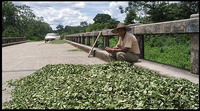Bolivia finds new way to fight against illegal coca
Bolivia opened a new front in its fight to reduce illegal coca production, sending eradication teams backed by U.S. into a traditional coca-growing region in the Andean foothills long avoided by previous governments.

But Bolivian officials described the program more as a shift in strategy to confront the country's fastest growing coca-producing area than an effort to increase total coca eradication.
President Evo Morales, a former coca farmer, has said he is concerned about the increasing coca crop in the Yungas, a stretch of steep green Andean foothills northeast of the capital La Paz.
The Yungas is Bolivia's oldest coca growing region and produces most of the small green leaves chewed by Bolivians for millennia as a mild stimulant and treatment for altitude sickness. But an unknown portion of its crop also is converted into cocaine, mostly for shipment to Brazil and Europe.
In recent decades, the Yungas crop has expanded to an estimated 18,500 hectares (45,700 acres), well beyond the 12,000 hectares (30,000 acres) protected by a 1988 Bolivian law.
Past eradication strategies largely ignored the larger Yungas crop to focus on the Chapare coca region, near the central city of Cochabamba.
Last year, Bolivian cooperative eradication programs paid for by the U.S. destroyed some 5,000 hectares (12,350 acres) of coca, nearly all in Chapare.
The total met the minimums set by Bolivian law and international treaty but ranked as the lowest in the last decade, prompting U.S. criticism.
Vice Minister of Social Defense Felipe Caceres told the Bolivian newspaper La Razon that the government hoped to meet half this year's minimum through eradication in the Yungas, while the other half of the required 5,000 hectares would be in the Chapare.
In keeping policies of the Morales' administration, the program will be done in cooperation with local farmers' groups and allow each family keep one "cato" of the crop each, equal to 1,600 square meters (one-third of an acre).
The new eradication push will be based in Caranavi, 100 kilometers (60 miles) northeast of La Paz. Farmers in the hills surrounding the small city have a reputation as a tough sell on reducing their crops.
The United States withdrew alternative development aid to the area last year after reporting threats against its workers, and last year coca farmers in a nearby town briefly kidnapped a government minister to protest eradication plans.
The United Nations estimated Bolivia's 2005 coca crop at 25,400 hectares (62,700 acres), making it the world's third largest producer of the leaf behind Colombia and Peru.
Subscribe to Pravda.Ru Telegram channel, Facebook, RSS!




